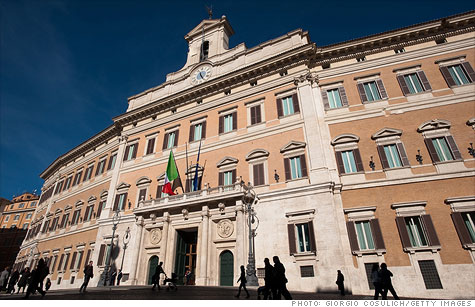Search News

FORTUNE -- The surprise downgrade of Italy's sovereign debt overnight by Standard and Poor's exposes the fatal flaws of pushing through draconian austerity measures on a nation experiencing economic weakness.
Cutting services and raising taxes will slow economic growth, making heavily indebted countries like Italy and the rest of the eurozone periphery more of a credit risk than ever before. This creates a downward spiral in which a country becomes dependent on bailouts until it finally defaults. The volatility created by this downgrade will produce a considerable amount of uncertainty in the markets in the coming weeks, keeping many investors on the sidelines.
S&P downgraded Italy's long-term and short-term sovereign debt rating one-notch to A/A-1. The nation was put on a "Negative Outlook" by S&P in the summer as the euro crisis intensified.
At 1.9 trillion euros, the Italian debt market is one of the largest and, up until this summer, one of the most liquid debt markets in the world. In downgrading Italy, S&P said it was concerned that the country could be shooting itself in the foot by passing a massive austerity plan last week. It fears that the plan could lead to "more subdued external demand," therefore reducing economic growth. This reduced growth rate would then make it unlikely that Italy could hit its fiscal targets, like attaining a balanced budget by 2013.
Italy didn't take on this 55 billion euro austerity plan on a whim -- it was essentially forced to do it by the European Central Bank. Earlier this summer, the euro contagion caused investors to step away from Italian bond auctions, forcing Italian bond yields to skyrocket. This increased Italy's funding costs and raised the possibility that there could be a failed auction for future debt offerings. Italy depends on rolling over its huge debt load to stay solvent, so a failed auction would be devastating.
To offset this risk, the ECB came out and started buying Italian bonds on the secondary market, essentially taking the place of skittish private investors. This move by the ECB was done on the condition that Italy meets certain fiscal targets to get its economic house in order. It was similar to the demands placed on Greece last year when that nation's debt market froze up, forcing the ECB and the International Monetary Fund to bail it out.
Growth is key
One would think that austerity would be a good thing for a nation with a crushing debt load that's 120% of its GDP like it is in Italy. But not all austerity is the same. Instead of making tough structural changes to the Italian economy in its austerity package, the Italian state decided to simply raise taxes and cut jobs.
In fact, around two-thirds of the 55 billion euro austerity plan will come from higher taxes, according to UBS. That will have a more depressive effect on growth than lower expenditures. Furthermore, the cuts in spending that were approved could cost thousands of workers their jobs, further slowing growth as unemployment grows.
It is almost impossible for a country to work itself out of an economic hole by slashing spending and raising taxes alone. It needs to grow its way out of the hole, something that looks increasingly difficult for Italy and other members of the eurozone periphery. To see an example of this, one needs to just look at what has occurred in Greece over the last 18 months. Harsh austerity measures pushed on the country by the ECB and IMF forced the country to lay off thousands of workers and raise taxes. This has had a devastating effect on the Greek economy. Its GDP shrank 6% in 2010 and 7.3% in the second quarter of this year -- far worse than anyone imagined.
To get its next round of bailout money, which is currently being debated, the country has had to slash even more jobs and institute a special tax on property to try and meet fiscal targets from the ECB and IMF. This will further lower growth rates in the country, causing it to miss revenue targets and potentially force it to seek further bailouts. This downward spiral is why the market is pricing in an almost certain Greek default sometime in the near future.
What happens after a Greek default
While Italy isn't as bad as Greece, it could very well fall into the same trap that has ensnared its Mediterranean neighbor. To avoid this outcome, Italy needs to make real structural changes to its economy, starting with reformation of its labor laws, which makes it very difficult to hire and fire workers.
The country could also boost growth by reducing public ownership in some of its largest corporations to encourage foreign direct investment. Italy would also be wise to steer its economy away from manufacturing and toward services. This structural shift, which the U.S. undertook painfully 30 years ago, should include higher spending on technology and other 21st century economic growth engines.
S&P has sent a clear message to Italy that growth is key to its economic survival. It is a message that other nations, both inside and outside the eurozone, would be wise to listen to if they want to avoid a downgrade in the near future. ![]()
| Overnight Avg Rate | Latest | Change | Last Week |
|---|---|---|---|
| 30 yr fixed | 3.80% | 3.88% | |
| 15 yr fixed | 3.20% | 3.23% | |
| 5/1 ARM | 3.84% | 3.88% | |
| 30 yr refi | 3.82% | 3.93% | |
| 15 yr refi | 3.20% | 3.23% |
Today's featured rates: